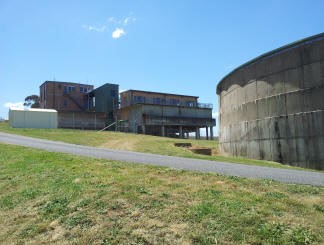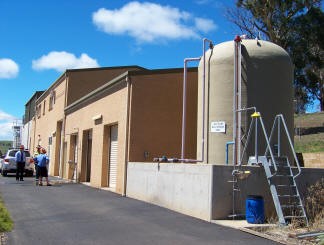Treatment and Distribution
A raw water supply usually contains suspended matter, colour, turbidity and possibly iron and manganese. The turbidity is due to finely divided matter held in suspension. It is usually too light to settle except after long periods of time. Colour is caused by dissolved organic material resulting from decaying vegetation and bacterial action.
To ensure the water that we produce meets NHMRC guidelines for potable water, the raw water supply goes through several treatment steps. This process begins with aeration during destratification of the dam, followed by the processes of coagulation and flocculation, clarification, filtration, pH correction, chlorination and fluoridation. These processes take place at the water treatment plant. Central Tablelands operates two treatment plants, Blayney water filtration plant and Carcoar water filtration plant.
Following treatment the water is carried to consumers via the distribution system.
Central Tablelands Water adds the following chemicals to its water supply: Aluminium Sulphate (Alum), Sodium Carbonate (Soda Ash), Chlorine, Fluoride.
The need for these chemicals is explained under the relevant sections detailing each treatment process. The concentrations and dosing rates of these chemicals vary over time. These variations are due mainly to changes in the quality of the source water, which in turn is caused by seasonal variations and storm events.

Destratification
Temperature differences and atmospheric conditions set up circulating currents in any body of water. The depth to which these currents penetrate depends upon many conditions, but most bodies of water show similar seasonal variations. In summer, the water becomes stratified in two distinct layers. A shallow surface layer which is continuously mixed by wind actions and day and night temperature variations, and a bottom layer which is virtually stagnant. During the summer, there can be very marked differences in the chemical and physical characteristics of these two layers.
As summer passes into winter, and atmospheric temperatures become colder, the depth of the surface layer increases until, at mid-winter, uniform conditions exist from top to bottom of the storage. Usually the final stage of the mixing occurs very suddenly with a large volume of bottom water rising to the surface. This is known as a turnover. If the bottom water was stagnant with a large concentration or iron, such a turnover can render the whole body of stored water unfit for use.
There is no way of preventing this natural phenomenon except by providing artificial circulation. This is done by means of an air compressor and a perforated hose in the dam. The air provides not only a means of circulating the water, but also pretreatment of the water, as the aeration causes iron and manganese to settle out of solution. This results in a higher quality source water entering the treatment plant.
Coagulation and Flocculation
During coagulation a chemical coagulant (aluminum sulphate) is added to the water. Aluminium sulphate is added to the water at a rate of between 40 and 80 mg/l. The coagulant reacts with the material in the raw water and causes the fine suspended material and colour in the water to draw together into gelatinous clusters which appear to the eye like miniature snow flakes. The name given to these is floc. The water between the floc is virtually clear.
Chemical coagulation conditions the water for further treatment by the removal of: turbidity, colour and bacteria; iron and manganese; tastes, odours and organic pollutants.
The chemical coagulants must be added to the raw water in the correct proportion to produce a large floc in sufficient quantity to absorb and remove all the impurities. As soon as the correct quantity of coagulating chemical has been added to the water the two must be quickly and thoroughly mixed to provide a treated water in which the correct amount of coagulant is uniformly distributed.
After the addition and mixing of the chemicals the treated water is next subjected to a period of gentle agitation. This not only provides chemical reaction time but is also necessary to keep the precipitated coagulant in suspension until it has had sufficient time to collect into floc clusters a maximum quantity of fine suspended particles.
When the particles of floc collide as a result of the gentle movement they cling together and eventually build up into much larger particles which settle more rapidly. This process is known as flocculation. Flocculation takes place in the clarifier.

Clarification
After coagulation the water enters the clarifier. The clarifier is a pyramid-shaped settling tank, also known as a sedimentation tank. The flocculated water rises slowly and spreads out as the cross-section of the tank increases. Near the top of the pyramidal section of the tank a point is reached where the downward gravitational force on the floc is equal to the upward force due to the water velocity. The floc therefore remains suspended. In time the volume of suspended floc builds up to form what is termed a sludge blanket. When the sludge blanket is well formed and dense, the settled water is quite clear.
The now clarified settled water is drawn off the surface of each tank by rows of decanting trays which convey the water to the settled water channel into the sand filters. Excess sludge is drawn off periodically and taken to drying lagoons. Waste water is regularly decanted from the lagoons and is recycled. Dried sludge is disposed of to landfill.
Filtration
Filtration is relied upon for the final and complete removal of any finely divided suspended matter, plus any floc carry over which remains after coagulation and clarification. By far the most common method of filtering domestic water supplies is through a bed of sand.
Water enters the top of the filter and flows through the layers of fine sand. As it does any extraneous matter is either filtered out, or adsorbed onto the filter media. When the filter media becomes clogged the filters are backwashed and the backwash water is discharged to the sludge lagoons.
pH Correction
During the chemical processes involved in flocculation, the pH of the water is reduced. The pH must be corrected, i.e. raised to a more alkaline level, to prevent it from causing corrosion as it travels through the reticulation network. Some treated waters may attack iron to give red water or rust if not corrected. They can also leach out the lime from cement lined pipes in the distribution network and cause corrosion of consumer fittings.
The water is brought to a condition where it is no longer corrosive. This correction is achieved by adding soda ash to the water. Chemically coagulated waters usually require to be stabilised by pH correction. The pH of the Lake Rowlands water ranges between 7.0 and 7.7. pH correction is achieved by the addition of a dense grade Soda Ash at a rate of 20 to 40 mg/l.
Chlorination
Chlorine is used as a disinfecting agent to assure the bacterial safety of the drinking water, and provide protection against possible later contamination in the distribution system. The normal dosage rate is 1.5 to 4.0 mg/l.
The dosage rate is calculated to ensure that a chlorine residual of 0.1 to 0.4 mg/l. remains in the reticulated water. This is done to kill off any bacteria encountered in the distribution system.
Fluoridation
Finally, fluoride is added into the treated water. Fluoride is added as an aid to public health. Low levels of fluoride (0.6 to 1.5 mg/l.) are required for the proper development and prevention of dental cavities in children's teeth. The normal dosage rate is 1.0 mg/L.

30 Church Street BLAYNEY NSW 2799
Postal Address: PO BOX 61, BLAYNEY NSW 2799
Ph: (02) 6391 7200
email: water@ctw.nsw.gov.au
QUICKLINKS

© 2019 Central Tablelands Water | Website by Ready Marketing
